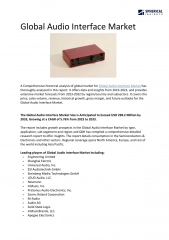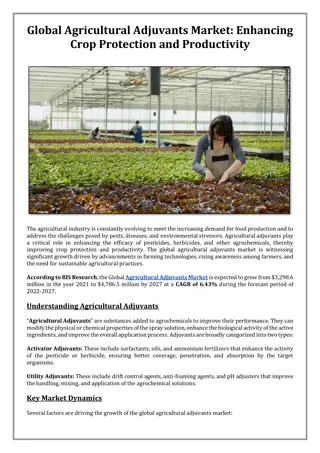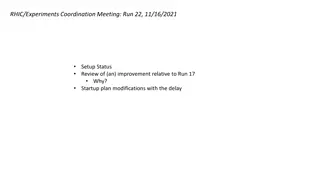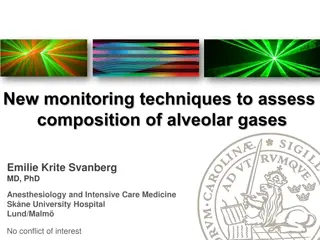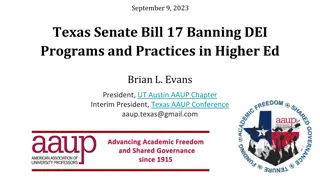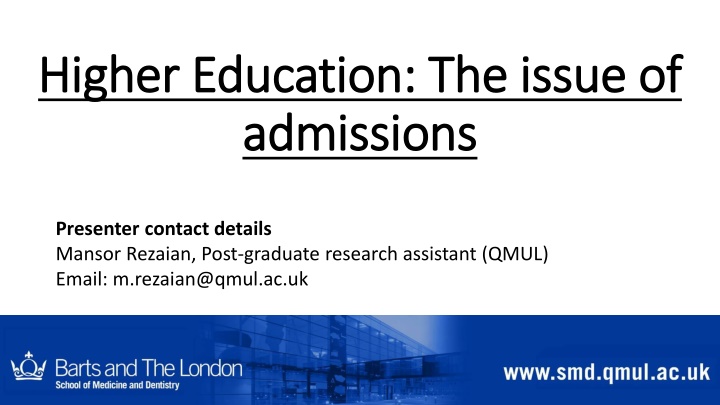
Contextual Data in Higher Education Admissions
Explore the challenges and insights into the use of contextual data in higher education admissions, focusing on the fairness and equality issues surrounding applicant opportunities and markers used for selection. Discover findings from interviews with HE institutions and medical schools in the UK.
Download Presentation

Please find below an Image/Link to download the presentation.
The content on the website is provided AS IS for your information and personal use only. It may not be sold, licensed, or shared on other websites without obtaining consent from the author. If you encounter any issues during the download, it is possible that the publisher has removed the file from their server.
You are allowed to download the files provided on this website for personal or commercial use, subject to the condition that they are used lawfully. All files are the property of their respective owners.
The content on the website is provided AS IS for your information and personal use only. It may not be sold, licensed, or shared on other websites without obtaining consent from the author.
E N D
Presentation Transcript
Higher Education: The issue of Higher Education: The issue of admissions admissions Presenter contact details Mansor Rezaian, Post-graduate research assistant (QMUL) Email: m.rezaian@qmul.ac.uk
Projects considered in this presentation Projects considered in this presentation 1. Contextual data in medical school selection (Profs Jen Cleland, Fiona Patterson, Liz Thomas and Dr Sandra Nicholson, Fran Cousans and Mansor Rezaian) 2. The factors that impact on WP students success (Dr Sandra Nicholson, Mansor Rezaian)
Project 1: Contextual data, medical school Project 1: Contextual data, medical school selection (Aims) selection (Aims) Gain more understanding of how medical schools: access, verify and use different CA measures To look into bigger picture factors around the use of contextual data (e.g. data sources)
Methodology Methodology Semi-structured telephone interviews 19 HE institutions/medical schools across the UK 26 interviews (7 of which were central admissions staff) Digitally audio-recorded Thematic analysis conducted on transcripts Content- and process-related themes obtained (Ritchie & Spencer, 1993)
Results 1: Understanding contextual data and Results 1: Understanding contextual data and its issues its issues Impediment and fairness/equality themes dominated understandings of CA Both highlighted an applicants level of opportunity to enter into higher education and medical school Issues: Reliability of markers (e.g. issues of self-reporting) Limitation of any one marker to account for applicants disadvantage Limitation (of data providers such as UCAS) Lack of a widening participation definition Cut-off point for the use of CA and the problem of a squeezed middle
Results 2: What markers were used and why? Results 2: What markers were used and why? School performance and geo-demographic indicators (e.g. POLAR data) were the most commonly used Availability and reliability were the main rationales for why these were chosen and why other CA were not In other cases: Care status, eligibility for free school meals, first in their family to enter into higher education and whether an applicant had been on a widening access scheme
Results 3: The prospect of a central repository/guidance Results 3: The prospect of a central repository/guidance for contextual data for contextual data Seen as crucial for the take up of more CA beyond school performance and geo-demographical markers Good for ensuring that there is more consistency in what data is used Good for encouraging transparency and fairness consistently Welcomed in theory but questionable in practice due to local specificities
Result 4: What happens as a result of contextual data Result 4: What happens as a result of contextual data being used? being used? Adjusted entry Automatically granting the opportunity to be interviewed Gateway programmes Increased number of interviews specifically for CA applicants Tailored medical programmes specifically for flagged applicants
Questions to consider from the findings Questions to consider from the findings Should efforts be made to encouraging schools move beyond school performance and geo-demographic markers? Should we look into formulating and employing a standardised (albeit imperfect) definition of WP to apply to applicants? Can a centralised guidance and repository system for schools in the UK be implemented in practice?
Project 2: WP students attainment/progression Project 2: WP students attainment/progression (Aims) (Aims) To examine the determinants affecting WP students attainment and progression
Methodology Methodology Mixed-methods Quan Sample: Humanities/Social Sciences and Science/Engineering students who enrolled in 2012- 13, (n=710) Qual sample: 10 Semi-structured interviews
The issue of clearing The issue of clearing Those who had not entered via clearing had, on average, end of year average marks that were higher by: Year 1 Year 2 4.3% (p=0.084) 5.7% (0.074)
Qualitative findings to the issue of clearing Qualitative findings to the issue of clearing Clearing was often taken by those who had an unsmooth trajectory into HE This encouraged a particular HE mind-set based around: inadequacy and regression you already think to yourself, I did kind of rubbish and then once clearing starts, it just gets worse...you feel like the lowest in this big pile of people looking at the courses no one wants (R.H. Business Management)
Further qualitative findings Further qualitative findings Those entering via clearing are not a homogenous group S&E students were more likely than HSS students to adapt to the situation by choosing modules associated to their original programme choice They were also more likely to have favourable interactions with faculty staff during the clearing process
I wanted to do Electronic Engineering, that didnt really happen and I was really down at the start the good thing was that I was able to pick some of the engineering modules with my computer science degree so I sort of did a pick and mix with things, making the degree suit me (M.S. Computer Science)
Questions to consider from the findings Questions to consider from the findings Should we look into formulating and employing a standardised (albeit imperfect) definition of WP to apply to applicants? [Again!] Clearing was found to impact attainment, but it is not a WP indicator as such, should clearing be managed differently according to whether students are WP or non-WP?
References References Fair Access to Professional Careers. A progress report by the Independent Reviewer on Social Mobility and Child Poverty. 2012. Garlick PB, Brown G. (2008). Widening participation in medicine. BMJ;336:1111 3. Hilton-Smith, T (2012) Widening Participation in Higher Education Casting the Net Wide?. Palgrave Macmillan, UK Millburn A. University challenge: how higher education can advance social mobility. Higher Education Empirical Research Database. 2012 p. 1 94. Thomas L. Do Pre-entry Interventions such as Aimhigher Impact on Student Retention and Success? A Review of the Literature. Higher Education Quarterly. 2011;65(3):230 50.

